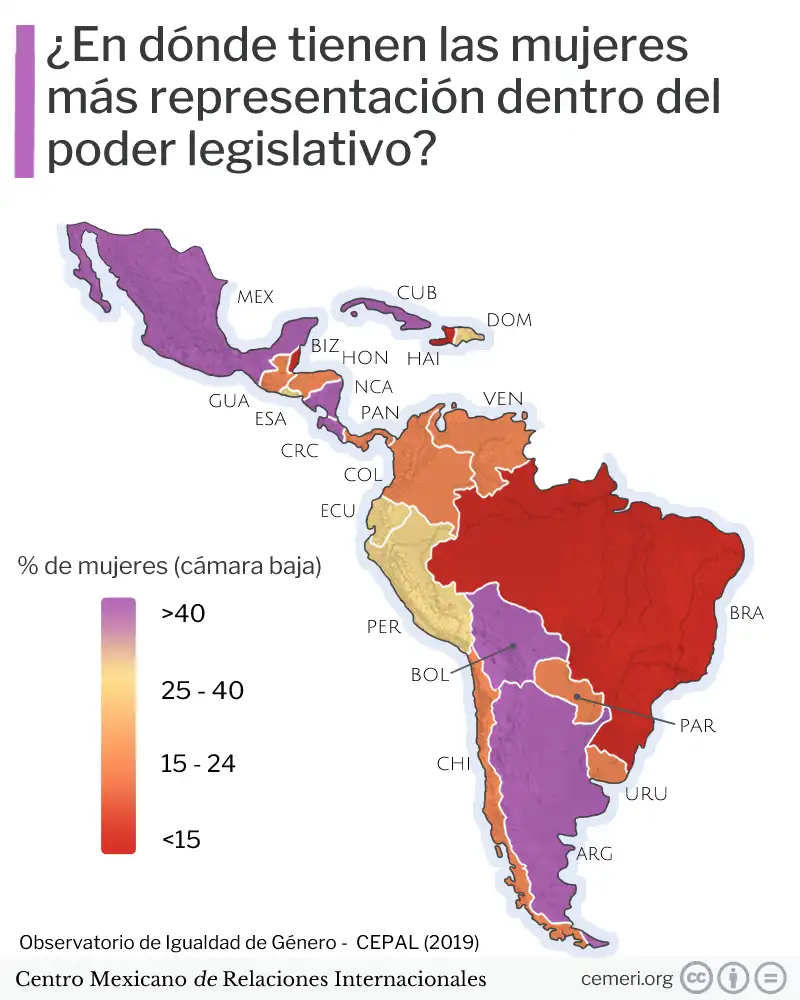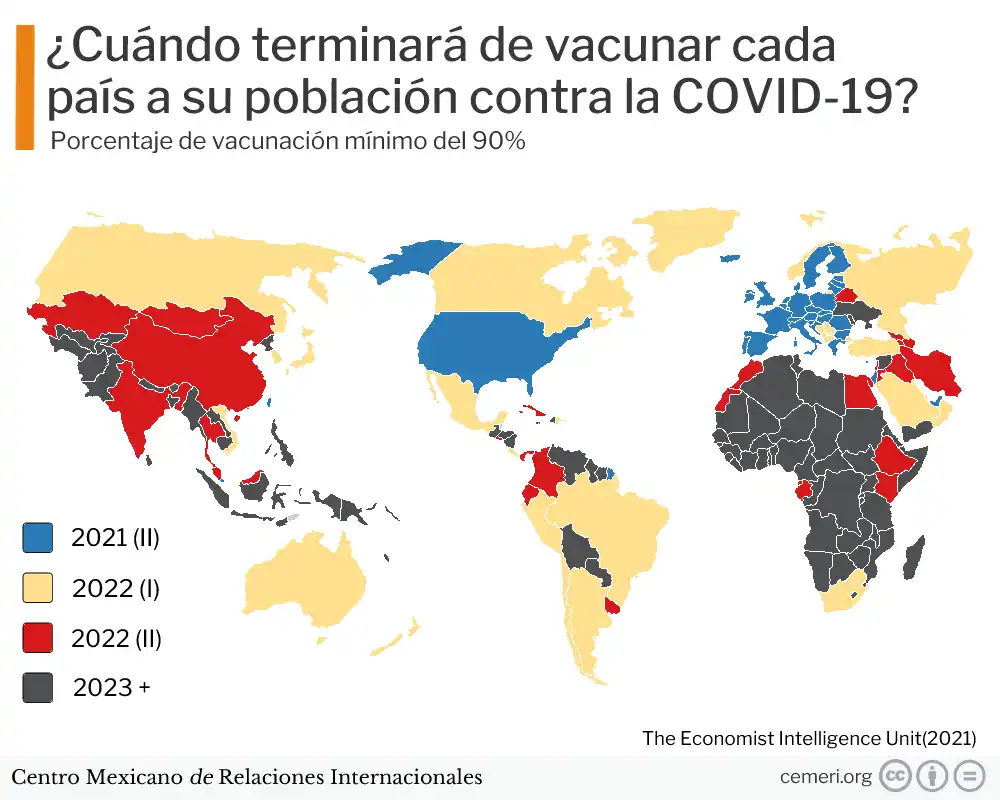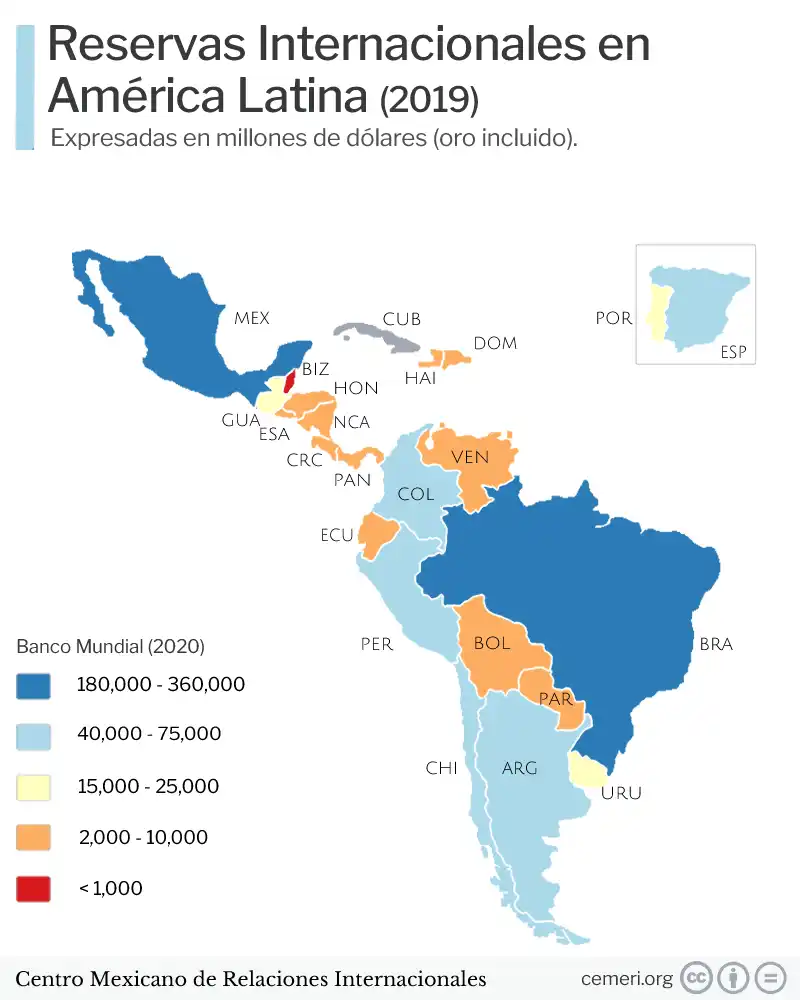Map
Valeria Fabiola Flores Vega
Where do women have more representation within the legislative branch?
- A general balance shows that most of the Latin American countries have made modest progress in their process of building a more equitable society.

What is gender parity?
Gender parity is the “balanced participation and representation of women and men in positions of power and decision-making in all spheres of life (political, economic and social)”[1]; This balance seeks to better represent the population of a certain country and take into account the interests of women in the development of public policy.
Currently, this index is also used to measure the democracy of countries, so its importance also falls in this area. **“**In short, the implementation of the principle of parity contributes to guaranteeing the principle of equality, promotes a more plural and diverse debate advancing in the inclusion of the gender perspective in public affairs and guarantees the democratic legitimacy of the spaces decision”[2]
The reasons why this concept is important are delimited in 3 pillars:[3]
- Equal democracy:
For a democracy to be full, it must be inclusive of women (and socially marginalized sectors). In addition to the right to vote, women must have the right to be elected to executive, legislative, and judicial positions.
- Inequality:
The lack of representativeness has repercussions on the elaboration of public policies that do not take into consideration the particular conditions or needs of this sector of the population, contributing to the invisibility of the social, economic and political problems of women. It is important to clarify that gender parity contributes to the aforementioned, but it is necessary that there are adequate institutional conditions and a public agenda consistent with this objective.
- Power relations:
As feminist theories have shown, power relations exercised based on gender (man at the top of the hierarchy) in the private sphere are reflected in the public sphere. The presence of women in government positions and in international organizations contributes to the breakdown of gender roles that have historically hindered the full development of women's capacities and abilities.
At the international level, an agenda has been promoted in which the consolidation of gender parity has been a priority. The 1952 Convention on the Rights of Women was the first instrument that recognized the right of women to political participation. Subsequently, in 1985 the Convention for the Elimination of all Forms of Discrimination against Women (CEDAW) was drawn up. Through these instruments, the States committed themselves to eliminate discrimination against women in all spheres, of course, including the political one.[4]
Gender parity in Latin America:
The Latin American region is the most unequal region in the world.[5] This is also reflected in terms of gender parity in the legislative sphere; On the one hand, we have countries like Cuba, Bolivia, Mexico or Costa Rica whose percentage of women in parliament exceeds 40% and, on the other hand, we have countries like Haiti, with barely 2.5%.
A general balance shows that most of the Latin American countries have made modest progress in their process of building a more equitable society. If a comparative exercise is made with the data for 2010 and 2019 (including: Antigua and Barbuda, Bahamas, Saint Vincent and the Grenadines, Saint Lucia, Barbados, Saint Kitts and Nevis, Trinidad and Tobago, Suriname, Dominica and Guyana), a regional increase of 8.1% can be found, considerable progress. However, it is a fact that gender parity in the political and legislative arena is not yet a reality.
Gender parity in Mexico:
In the specific case of Mexico, gender parity is a constitutional principle and, in recent years, there has been significant progress in this area. As can be seen on the map, Mexico is one of the countries in which gender parity is almost met, we found that 48.2% of the members of the legislature correspond to women's positions. At the same time, it is necessary to mention that in the country's local congresses there is a gender parity rule that "works as a mechanism for political equality and should be aimed at reducing the most important gaps between women and men".[6 ]
Despite the above, there are still important gaps to be closed in the country, for example, at the end of 2020, only 22% of the municipalities and mayoralties were governed by women.[7] Despite Although these are the highest figures recorded in the history of Mexico, they still represent a much lower percentage than that of positions held by men.
However, the case of Mexico is particularly special because, although the government currently almost achieves gender parity in the cabinet[8], the government, which in principle adopted an inclusive discourse with the feminist agenda, has abandoned the gender perspective in the development of public policies and has limited the incidence of women in public office to the point where they are forced to resign.
Conclusions:
Gender parity in the legislative field is extremely important for certain issues to be discussed and legislated on; Thanks to the women in the chambers, it has been possible to legislate on access to abortion, care tasks, wage gaps, among other problems. However, it is necessary to be careful because, as already mentioned, gender parity in the chambers by itself does not guarantee that the needs and demands of women are taken into account, as the Mexican case demonstrates.
Data:
| Country | % women |
|---|---|
| Haiti | 2.5 |
| Belize | 9.4 |
| Brazil | 14.6 |
| Paraguayan | 16.3 |
| Colombia | 18.3 |
| Guatemala | 19.4 |
| Honduras | 21.1 |
| Uruguay | 21.3 |
| Venezuela | 22.2 |
| Panama | 22.5 |
| Chile | 22.6 |
| Peru | 26.2 |
| Dominican Republic | 27.9 |
| El Salvador | 33.3 |
| Ecuador | 39.4 |
| Argentinian | 40.9 |
| Costa Rica | 45.6 |
| Nicaraguan | 47.3 |
| Mexico | 48.2 |
| Bolivian | 53.1 |
| Cuba | 53.2 |
| Average | 28.8 |
Source: Gender Equality Observatory for Latin America and the Caribbean. ECLAC.
Sources
1 Instituto Nacional de las Mujeres, “La paridad de género, un asunto de igualdad y de justicia”, Gobierno de México, https://www.gob.mx/inmujeres/articulos/la-paridad-de-genero-un-asunto-de-igualdad-y-de-justicia?idiom=es (Consultado el 09-03-2021);
2 Directorio Legislativo, “Paridad de género: una democracia sin mujeres no es democracia”, https://directoriolegislativo.org/blog/2016/08/26/paridad-de-genero-una-democracia-sin-mujeres-no-es-democracia/ (Consultado el 09-03-2021);
3 Barathe, Richard. “5 razones por las cuales la paridad es clave en las democracias de América Latina”, ONU Mujeres, https://lac.unwomen.org/es/noticias-y-eventos/articulos/2019/1/5-razones-para-la-paridad-e (Consultado el 09-03-2021);
4 Directorio Legislativo, “Paridad de género: una democracia sin mujeres no es democracia”, https://directoriolegislativo.org/blog/2016/08/26/paridad-de-genero-una-democracia-sin-mujeres-no-es-democracia/ (Consultado el 09-03-2021);
5 Forbes Centro América,””América Latina y el Caribe siguen siendo la región más desiguald del mundo”: Alicia Barcena”, Forbes Staff, https://forbescentroamerica.com/2020/06/15/america-latina-y-el-caribe-siguen-siendo-la-region-mas-desigual-del-mundo-alicia-barcena/#:~:text=hacia%20el%20desarrollo%3F-,Am%C3%A9rica%20Latina%20y%20el%20Caribe%20siguen%20siendo%20la%20regi%C3%B3n%20m%C3%A1s,brechas%20de%20desigualdad%20en%20ingresos (Consultado el 08-03-2021)
6 Centro de Investigación y Política Pública (IMCO), “Paridad de género en el poder legislativo”, IMCO Staff, https://imco.org.mx/informe-legislativo-2018-paridad-genero-poder-legislativo-2/ (Consultado el 09-03-2021);
7 Milenio, “Sánchez Cordero: 22 por ciento de municipios son gobernados por mujeres”, Redacción, https://www.milenio.com/politica/segob-22-ciento-municipios-gobernados-mujeres; (Consultado el 09-03-2021);
8 El Financiero, “Paridad de género al gabinete llegó con gobiern de AMLO: Sanchez Cordero”, Redacción: https://www.elfinanciero.com.mx/nacional/paridad-de-genero-al-gabinete-llego-con-gobierno-de-amlo-sanchez-cordero; (Consultado el 09-03-2021).

